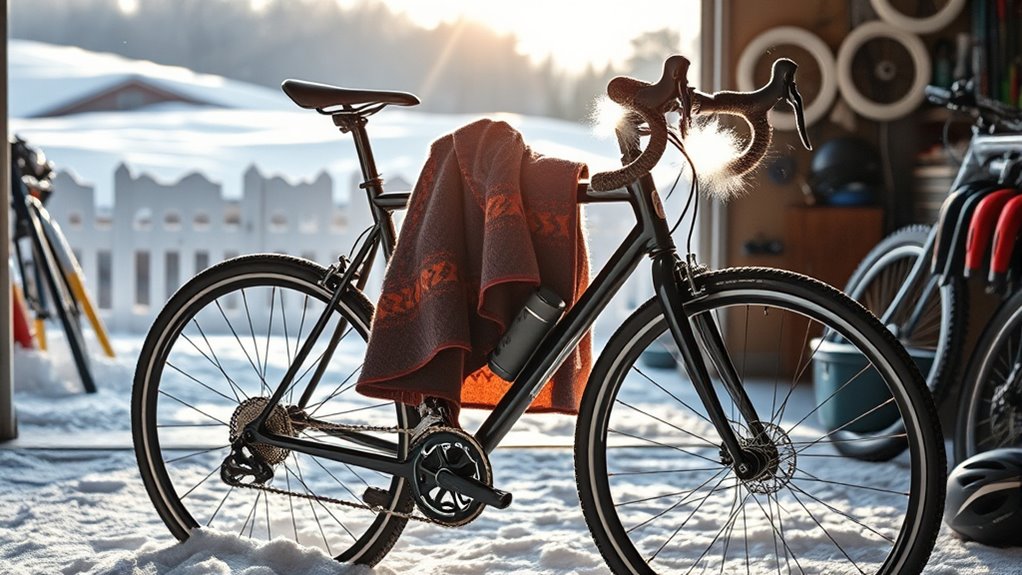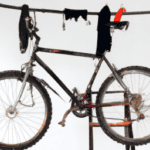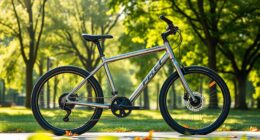To winterize your bike, start by cleaning it thoroughly, changing the fluids, and inflating the tires to the recommended pressure. Disconnect the battery and store it in a dry, warm place. A good bike cover is essential for protection against dust and moisture. Finally, choose a dry, secure storage location. Following these steps will keep your motorcycle in top condition until spring. Keep going to discover more essential tips for winter storage!
Key Takeaways
- Clean your bike thoroughly and apply a light coat of wax to protect against dust and moisture during storage.
- Change engine oil and fluids, and add fuel stabilizer to prevent degradation and corrosion over the winter months.
- Inflate tires to the recommended pressure and store your bike on a stable surface to avoid flat spots.
- Disconnect and store the battery in a dry, warm location, monitoring its charge periodically to maintain performance.
- Use a climate-controlled storage space and secure your bike with high-quality locks to prevent theft and damage.
Clean Thoroughly
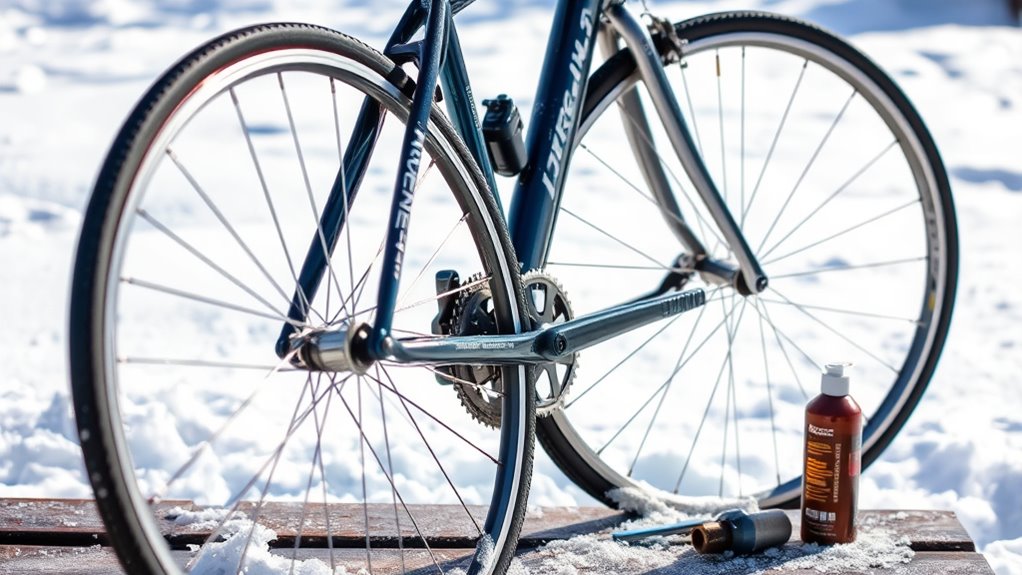
Before you tuck your bike away for the winter, it’s important to clean it thoroughly. Start by washing your motorcycle with mild soap and warm water to remove dirt that can lead to rust or corrosion during storage.
Once you’ve scrubbed it down, dry your bike completely to prevent any moisture buildup. After drying, apply a light coat of wax to protect your bike from dust and environmental elements.
Don’t forget about the leather seats; clean them with warm water and a soft cloth, then condition them to keep them from cracking.
Finally, inspect and clean moving parts like the chain and cables to guarantee they’re lubricated and free from contaminants. A thorough cleaning now saves you headaches later! Additionally, consider how color accuracy can enhance your bike’s appearance when you decide to show it off in the spring.
Change Fluids
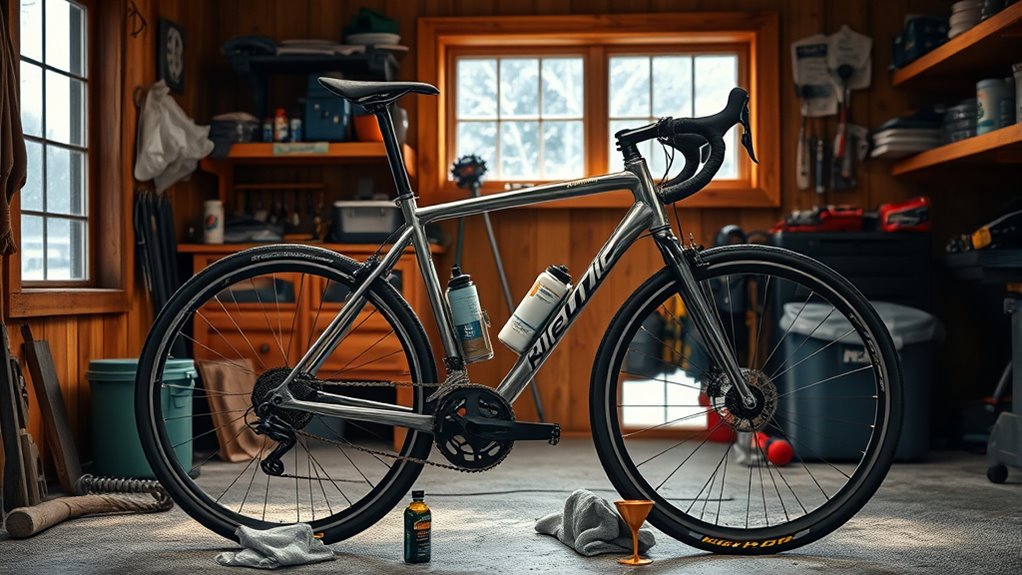
After cleaning your bike, the next step is to change the fluids. Start with the engine oil; regularly replacing it and the oil filter prevents sludge buildup and keeps your engine lubricated during storage.
Next, check the brake fluid, as it can absorb moisture over time, leading to corrosion and reduced braking efficiency. Make certain your coolant is at the proper level and type to avoid freezing issues.
Regularly inspect your brake fluid to prevent moisture absorption and ensure optimal braking performance, and check coolant levels to avoid freezing.
If you fill the gas tank, add a fuel stabilizer to prevent fuel degradation and varnish buildup. If you leave the tank empty, treat the fuel system to avoid moisture accumulation and rust formation in the tank and lines. Additionally, regular maintenance ensures peak performance post-storage, similar to tuning practices in automotive care.
Following these storage tips will guarantee your bike’s longevity.
Protect the Tires
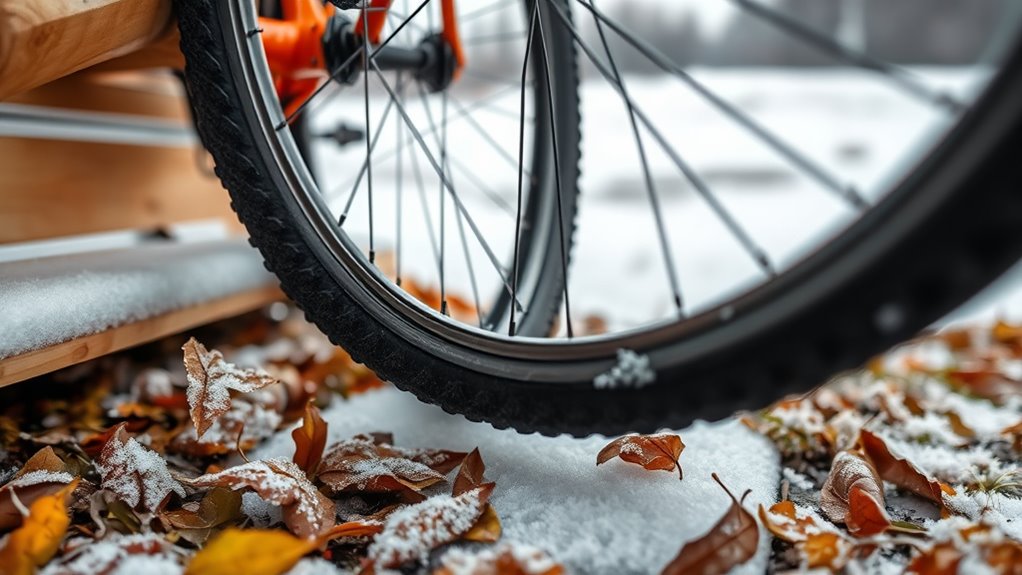
To protect your bike’s tires during winter storage, start by inflating them to the manufacturer’s recommended pressure. This helps prevent deformation and dry rotting.
Store your bike in a dry place on a stable surface, like plywood or carpet, to avoid flat spots.
Here are three tips to properly winterize your tires:
- Rotate the Tires: Roll your bike occasionally to maintain tire shape and avoid prolonged pressure in one spot.
- Lift Off the Ground: Consider using a delta bike stand or similar device to keep the tires off the ground for ideal preservation.
- Regularly Check Tire Pressure: Monitor the tire pressure throughout the storage period to confirm they remain adequately inflated and prevent rust. Additionally, ensure that your storage area is clear and accessible to facilitate easy maintenance and monitoring of your bike.
Disconnect the Battery
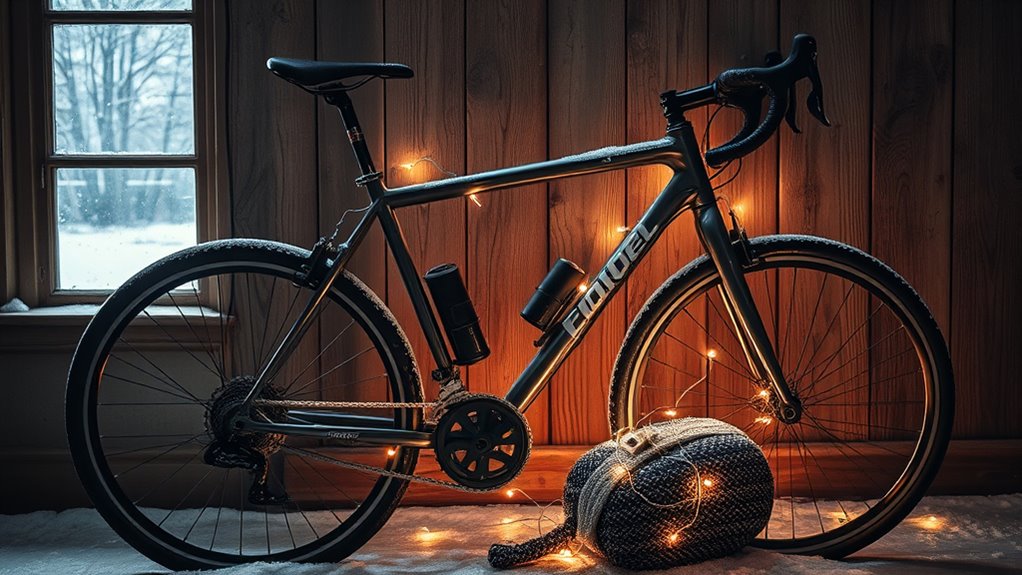
To keep your bike’s battery in top shape during winter, start by disconnecting it properly.
Make sure to store it in a warm, dry spot to prevent any damage from freezing temperatures.
Don’t forget to check its charge periodically and consider using a battery tender to keep it ready for spring. Additionally, maintaining a proper storage plan for your bike can help ensure all components remain in good condition during the off-season.
Battery Disconnection Process
As winter approaches, disconnecting your bike’s battery becomes essential for preserving its performance and lifespan. Cold temperatures can drain your battery, so taking the right steps guarantees it remains in top condition.
Here are some storage tips for the battery disconnection process:
- Clean Terminals: Confirm the battery terminals are clean and free from corrosion before disconnecting the battery. This helps maintain a good electrical connection.
- Use a Battery Tender: While the battery is disconnected, using a battery tender keeps it topped off and ready for the riding season.
- Store Properly: Keep your battery in a warm, dry place, ideally between 32°F and 70°F (0°C to 21°C), to prolong its lifespan. Additionally, maintaining a good electrical connection is crucial for optimizing battery performance.
Don’t forget to reconnect the battery before starting your motorcycle!
Storage Location Considerations
When deciding where to store your bike’s battery for winter, consider a location that stays warm and dry. Cold temperatures can cause the battery to lose charge and shorten its lifespan, so avoid damp or freezing areas.
Ideal storage options include a heated garage or a basement. If you want to make certain it’s ready for spring, using a battery tender during storage keeps the charge topped off and maintains overall health. Additionally, seeking professional help can provide guidance on maintaining your battery’s longevity through proper care.
Before storing, clean and secure the battery connections to prevent corrosion. If you opt for a maintenance charger, installing an SAE lead on the battery allows easy access, so you won’t have to remove the battery to keep it charged.
Proper winterizing now means a smoother ride later!
Maintenance During Storage
Storing your bike’s battery properly is only part of the winterizing process; disconnecting it during storage is equally important. This helps prevent loss of charge due to cold temperatures and guarantees a longer battery life.
Here are three key steps to maintain your battery during winter:
- Store in a Cool, Dry Place: This prevents damage from extreme conditions and maintains battery health.
- Use a Battery Tender: While disconnected, a battery tender keeps it topped off, guaranteeing it’s ready for spring.
- Monitor Charge Level: Regularly check the charge level during storage to avoid starting issues later.
Additionally, clean the battery terminals before storage to guarantee a good connection and prevent corrosion when you reconnect it.
Proper maintenance keeps your bike ready for action! Air quality improvement is also essential during winter, as indoor air can become stale and filled with pollutants.
Cover Your Bike
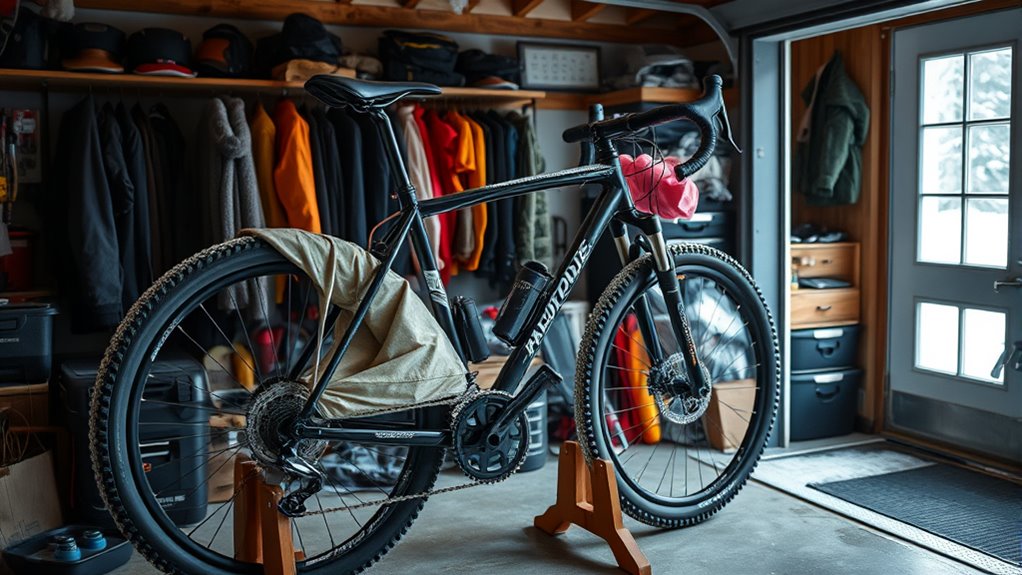
To keep your bike safe during the winter months, covering it is crucial. A breathable motorcycle cover is your best bet; it helps prevent moisture buildup while protecting your bike from dust, dirt, and scratches. Make certain the cover has a secure fit to prevent it from blowing off or letting critters access your motorcycle. Avoid non-breathable plastic covers, as they can trap moisture, leading to rust and corrosion. If you’re storing outdoors, choose a UV-resistant cover to safeguard your bike’s paint and components from sun damage. Regularly check the cover for wear and tear, replacing it as needed to guarantee adequate protection. Additionally, ensuring the cover is made from breathable material can further assist in preventing corrosion-related issues.
| Feature | Importance |
|---|---|
| Breathable Material | Prevents moisture buildup |
| Secure Fit | Keeps cover in place |
| UV-Resistant | Protects from sun damage |
Store in a Dry, Warm, and Safe Place

When it comes to winterizing your bike, finding the right storage location is essential.
You’ll want a dry, warm, and secure space to keep your motorcycle safe from moisture and temperature changes.
Whether it’s a garage or a rented unit, make sure it meets your bike’s needs for protection and security. Additionally, consider the impact of tire pressure adjustments as they can help prevent damage to your bike during the storage period.
Ideal Storage Locations
Choosing the right storage location for your bike is vital, as a dry, warm, and safe environment can greatly extend its lifespan.
To guarantee your motorcycle stays in top condition, consider the following storage options:
- Garage or Basement: Store your bike in a dry, temperature-controlled area to prevent rust and damage.
- Climate-Controlled Storage Unit: If indoor storage isn’t available, renting a climate-controlled storage unit can protect your bike from moisture and temperature fluctuations.
- Regular Inspections: Regularly check your storage area for moisture, pests, or chemicals that could harm your motorcycle. Additionally, maintaining optimal air quality through proper ventilation can prevent mold and mildew buildup.
Avoid storing your bike in damp or extremely cold locations, as these conditions may lead to costly repairs.
Proper winterize techniques are vital for preserving your bike during the off-season.
Security Measures Needed
Even in a well-chosen storage location, securing your bike is just as important to protect it from theft and damage during the winter months.
Opt for a storage space with climate control to keep moisture at bay and prevent corrosion. A high-quality lock or an alarm system is vital, especially since motorcycle thefts spike by up to 25% during the off-season.
If you can’t access a garage, consider renting a unit with robust security features. Regularly inspect your bike’s storage area for signs of moisture or rodents; a clean environment is essential for preventing damage.
Consider Additional Precautions
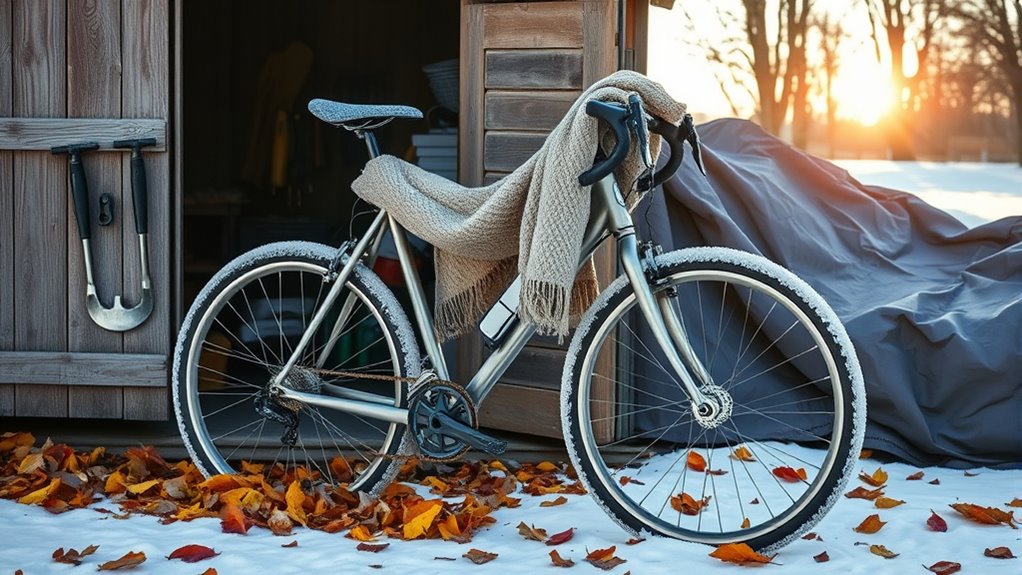
Taking extra precautions during winter storage can make a significant difference in the longevity of your bike.
Extra precautions during winter storage can greatly extend your bike’s lifespan.
As the risk of theft increases by 25% in winter, it’s essential to enhance your security measures. Here are three additional precautions to take into account:
- Review Your Insurance Policy: Verify your bike cover protects against theft and damage during winter storage.
- Keep Documentation: Maintain detailed records of your bike’s condition and storage location for potential insurance claims or maintenance.
- Use Rodent Deterrents: Seal any openings and use deterrents to prevent wildlife from causing damage to your bike’s wiring and components.
Frequently Asked Questions
How to Winterize a Bicycle for Storage?
To winterize your bicycle for storage, start by giving it a thorough cleaning with mild detergent and a soft brush. This removes dirt and moisture that can lead to corrosion.
Next, lubricate the chain and moving parts with quality bike lubricant. Inflate the tires to the recommended pressure to prevent flat spots.
Finally, store it in a dry, temperature-controlled area, and consider a breathable cover to protect it from dust.
How Do You Store Bikes Over Winter?
To store your bike over winter, keep it indoors in a dry, temperature-controlled space like a garage.
Inflate the tires to the recommended pressure to prevent flat spots.
Disconnect the battery to avoid discharge and consider a battery tender to maintain its charge.
Clean your bike thoroughly with mild soap and wax for protection, and use a breathable cover to shield it from dust while allowing moisture to escape.
Can I Store My Bike Outside in the Winter?
Storing your bike outside in winter is like leaving a flower out in a blizzard; it’s not going to thrive.
If you must, use a breathable cover to shield it from moisture and harsh elements. Plug exhaust openings to keep critters away, and elevate your bike to avoid that icy ground.
Regularly check on it to guarantee everything’s in good shape. You want your ride ready to roll when the sun shines again!
How to Store a Bike for 1 Year?
To store your bike for a year, start by changing all fluids to prevent corrosion.
Disconnect the battery and keep it in a cool, dry place, using a battery tender to maintain its charge.
Inflate the tires to the recommended pressure and consider using a stand.
Clean your bike thoroughly, applying protective wax and lubricating moving parts.
Finally, store it in a well-ventilated, dry area to avoid moisture buildup and rust.
Conclusion
As you tuck your bike away for the winter, remember it’s like hibernating a bear—preparing for the spring awakening. By cleaning, changing fluids, and taking protective measures, you’re not just storing it; you’re nurturing it for the rides to come. A little care now guarantees your bike will emerge ready to conquer the roads again, just as nature reawakens with each new season. So, embrace this time of rest and renewal for both you and your trusty steed.
